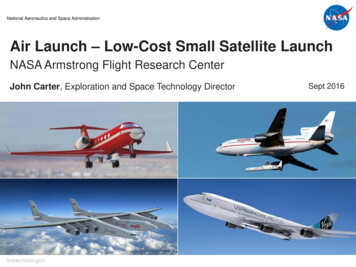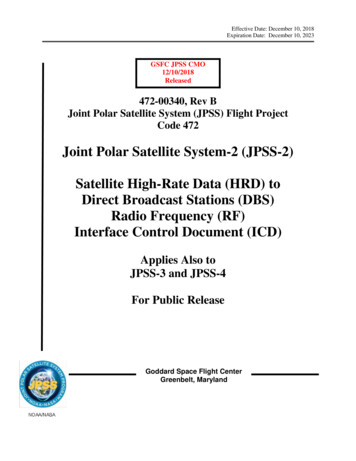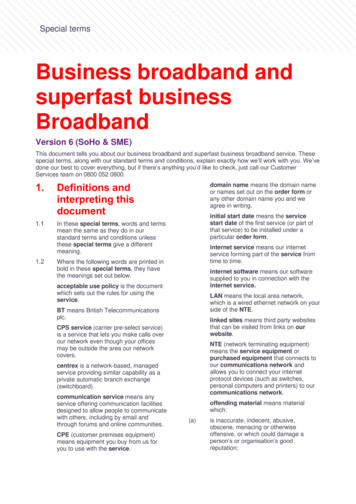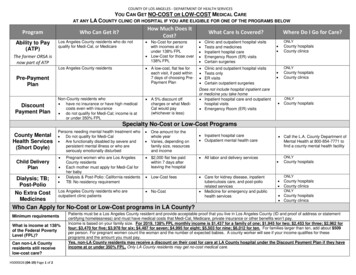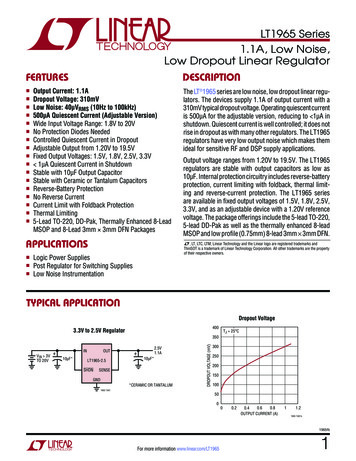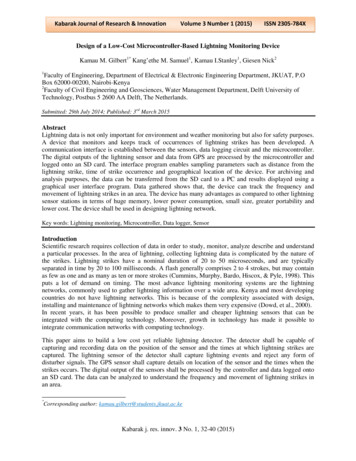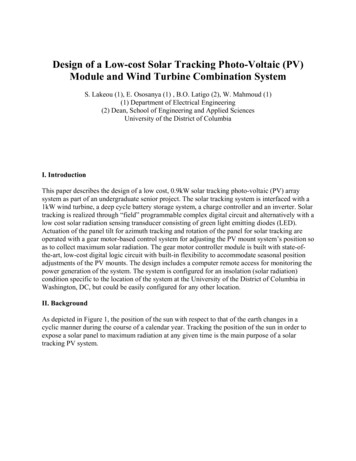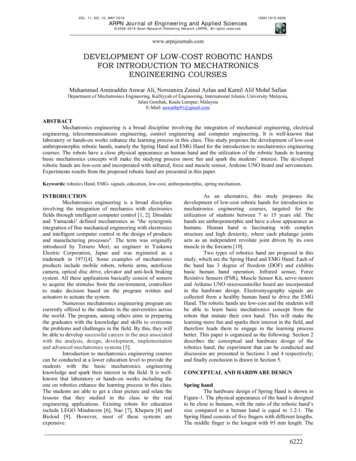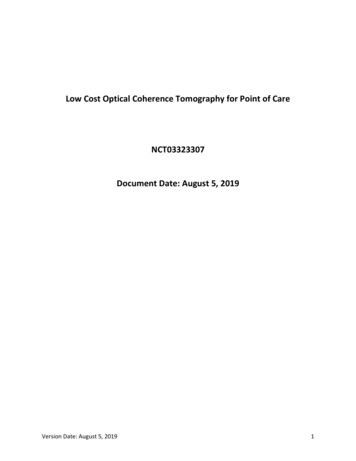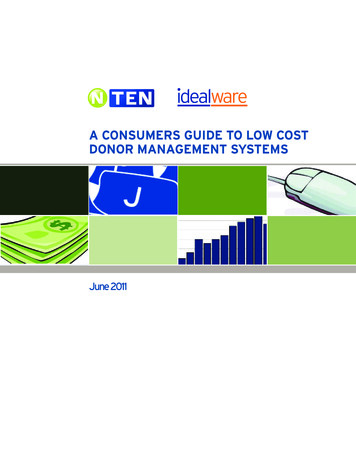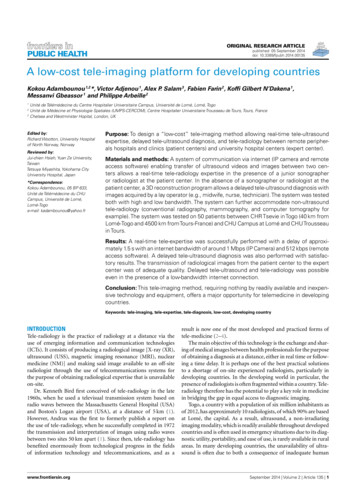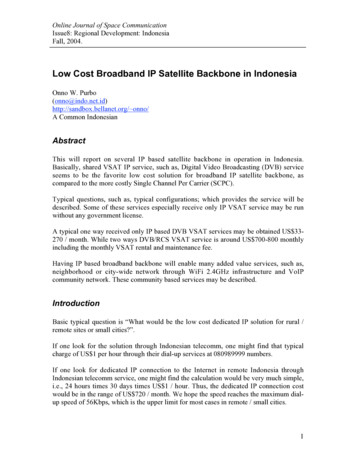
Transcription
Online Journal of Space CommunicationIssue8: Regional Development: IndonesiaFall, 2004.Low Cost Broadband IP Satellite Backbone in IndonesiaOnno W. / onno/A Common IndonesianAbstractThis will report on several IP based satellite backbone in operation in Indonesia.Basically, shared VSAT IP service, such as, Digital Video Broadcasting (DVB) serviceseems to be the favorite low cost solution for broadband IP satellite backbone, ascompared to the more costly Single Channel Per Carrier (SCPC).Typical questions, such as, typical configurations; which provides the service will bedescribed. Some of these services especially receive only IP VSAT service may be runwithout any government license.A typical one way received only IP based DVB VSAT services may be obtained US 33270 / month. While two ways DVB/RCS VSAT service is around US 700-800 monthlyincluding the monthly VSAT rental and maintenance fee.Having IP based broadband backbone will enable many added value services, such as,neighborhood or city-wide network through WiFi 2.4GHz infrastructure and VoIPcommunity network. These community based services may be described.IntroductionBasic typical question is “What would be the low cost dedicated IP solution for rural /remote sites or small cities?”.If one look for the solution through Indonesian telecomm, one might find that typicalcharge of US 1 per hour through their dial-up services at 080989999 numbers.If one look for dedicated IP connection to the Internet in remote Indonesia throughIndonesian telecomm service, one might find the calculation would be very much simple,i.e., 24 hours times 30 days times US 1 / hour. Thus, the dedicated IP connection costwould be in the range of US 720 / month. We hope the speed reaches the maximum dialup speed of 56Kbps, which is the upper limit for most cases in remote / small cities.1
Online Journal of Space CommunicationIssue8: Regional Development: IndonesiaFall, 2004.To be honest, US 600-800 / month for dedicated Internet connection would be out ofquestions for most Indonesians. Thus, the typical basic / common solution would beshared access cost through neighborhood network, school network, offices network etc.to obtain an affordable US 15-30 / month / house for 24 hours Internet connection. Theoperating cost calculation is quite straightforward, the monthly dedicated Internetconnection cost (US 600-800 / month) divide by the number of schools / neighbor /offices. A typical 20-30 neighbor is sufficient to reduce the monthly cost to an affordableUS 15-30 for individual users / houses.A neighborhood network is basically a cyber café technology with a proxy server orNetwork Address Translator (NAT) box to share a single Internet access to manycomputers behind the NAT box. Commonly used UTP (LAN) cables run across theneighborhood to connect all computers. Since UTP cable is limited to 100-200 meters,we normally putting a hub or switch box every 100-200 meters, to act as a repeater forthe LAN cables to reach longer distances.Neighborhood network has been a common solution for many Indonesian residentialareas. Unfortunately, the government has been very slow in responding to the regulatoryframework and has been considering such network as a not legal (but not really illegal)network.In some cases, we need to deploy a city wide area network. A typical city wide areanetwork must cover an area with radius 5-15 km (or about 25-150 km square). UTP /LAN based technology is not sufficient to cover such ranges. We normally used WiFi2.4GHz equipments to do the tasks. Most Taiwanese low cost WiFi 2.4GHz is normallydesigned for indoor usage. Most of us enclosed such equipments in plastics boxes,replace the default antenna using a high gain parabolic antenna and put it for 5-15 kmoutdoor operations.The individual charges can be extremely low for Internet connection to schools throughcity wide area network. Shared Internet access would cost about US 40-70 / month /school after sharing the backbone access to several schools within the city. Consideringtypical schools would have 500-1000 students, the final operating cost as well asinvestment for buying computers would be around US 0.20-0.50/student /month. Thereturn of investment for the computer equipment would be around one to two years time.The monthly cost in getting the community access as well as school access to the Internetcan be reduced significantly to sub-US 1 level per month per students. The wholeinvestment may be payback within 1-2 years time. The most important aspect of thewhole initiatives is the communities and the schools don’t have to rely on governmentfunding nor loan from the World Bank nor IMF.Thus, it solved most of our problems in getting low cost (and self-financed) access forneighborhood and city wide area network. Most of the technology is very well2
Online Journal of Space CommunicationIssue8: Regional Development: IndonesiaFall, 2004.documented and can be downloaded from many sites, such as,http://www.apjii.or.id/onno/, http://sandbox.bellanet.org/ onno/, http://www.apc.org/tiki/,and http://www.thewirelessroadshow.org.Having solved the neighborhood and city wide area network, our next task is to find thesolution for low cost nation or international access. There are basically two (2) majorcompeting technologies, i.e. satellite based or fiber optic based backbone infrastructure.In some / major cities, it is quite easy to find fiber optics backbone provided byIndonesian Telkom or XL http://www.xl.co.id (one of the Indonesian cellular operator).Due to bureaucratic reasons and service commitment, many of us would prefer to useXL’s fiber optics backbone infrastructure, ensuring high quality, high capacity, andreliable services. Combined with fixed wireless transmissions, VSAT, and submarinefiber optics, the network spans across Java, Bali, Lombok, Sumatra, Kalimantan,Sulawesi, and Singapore (as Business Solution’s international Leased Line gateway).Unfortunately, in many Indonesian areas, it would be difficult to get access to fiber opticsbackbone. Thus, the solution would be satellite based backbone infrastructure. The coststructure must remain about US 600-800 to reach an affordable US 15-30 / month enduser charges. In the next section, I will describe the situation in satellite based IPbackbone in Indonesia. To be honest, some of these activities are currently considered asnot legal. Although, it is not illegal either.Overview of Satellite Based IP Backbone TechnologyThere are basically two (2) major commonly used satellite based IP backbonetechnologies, namely, Single Channel Per Carrier (SCPC).Digital Video Broadcasting (DVB).SCPC technology is basically a dedicated media, in which, the satellite link is used forpoint to point only and not shared with other users. The quality of service of SCPC link isexcellent. Unfortunately, a 64Kbps SCPC link would cost us in Indonesia aboutUS 2000-2500 / month.To save the cost, one most share the satellite bandwidth / access with others and dividethe cost respectively. Digital Video Broadcasting (DVB) technology has the ability toshare a single satellite downlink to many users. The end users need to decode the datatransmitted from the satellite through a DVB card, which normally cost about US 100150, plug in a Windows or Linux box that will act as a router for the rest of the network.3
Online Journal of Space CommunicationIssue8: Regional Development: IndonesiaFall, 2004.Thus, a DVB box will solve for the incoming traffic from the Internet to theneighborhood or city wide network.Some DVB technology uses normally terrestrial network, such as, dial-up or 2.4GHzWiFi to route the outgoing traffic to the Internet.In some cases, getting a dial-up or 2.4GHz WiFi access to local Internet Service Provider(ISP) is out of questions. In such cases, we need satellite access for both incoming andout going traffic. Most commonly used DVB based technology for both incoming andoutgoing traffic is the DVB/FTDMA technology. Both incoming and outgoing traffic isshared over the satellite link. For a 64Kbps DVB/FTDMA shared access may cost aboutUS 200-700 / month depending on either we rent or having our own the VSAT groundstation.It is common to see a US 700/month DVB/FTDMA VSAT access is shared to a citywide area network through WiFi 2.4GHz City Wide Network, and then shared againthrough UTP / LAN neighborhood network to reach US 15-30/month/house.Let us now review some of the Satellite based IP backbone provider that run the servicein Indonesia.Received Only IP Based Satellite AccessInstalling and running a received onlysatellite ground station requires nolicensed from the Indonesian government.Thus, received only IP based satelliteaccess is the safest service that can beprovided to the Indonesian communitieswithout having to struggle in getting theany licensed from the government.Shown in the figure (copied fromhttp://www.makmurparabola.com) is theconfiguration of typical received only broadband IP based satellite link as thedownstream. It is fairly safe and no licensed is required. The request (upstream traffic)may be directed through a dial-up modem, or ADSL connection, or WiFi connection tothe Internet Service Provider.Received only IP based Satellite Access is normally used to increase the system capacityespecially for international traffic. It would be advisable to have a local Internet4
Online Journal of Space CommunicationIssue8: Regional Development: IndonesiaFall, 2004.connection to local Internet Exchange, such as, Indonesian Internet Exchange (IIX)http://www.iix.net.id before doing any received only IP based satellite access.Such configuration is normally used by corporate users, including cyber cafe, hotel,manufacturing industries, hotel etc. Personal / community network, including apartment,real estate etc. as well as personal users.5
Online Journal of Space CommunicationIssue8: Regional Development: IndonesiaFall, 2004.We need to set up a satelliteground station with a minimalparabolic antenna diameter of180 cm including the LowNoise Amplifier (LNA),coaxial cable (such as RG6)that costs about US 120-200 asshown in the figure fromMakmur Parabola; a pentiumIII personal computer256Mbyte RAM as DVBRouter with Windows or Linuxoperating system; Mikrotikroutersoftware(http://www.mikrotik.com); adial-up 56Kbps modem forInternet dial-up connection, or ADSL, cable modem, 2.4GHz WiFi connection for uplinkconnection.The key equipment would be a DirecPC or DVB card, such as, Penta Value orBroadlogic 2030, that can decode downlink data from the satellite. A DirecPC or DVBcard, including CD-ROM and manual would normally cost about US 250. A registrationfee of US 100 is fairly typical to use the service.There are several received only IP based satellite access that served the Indonesianclients, such as,Makmur Parabola (http://www.makmurparabola.com). Makmur Parabola is not alicensed telecommunication serviceprovider. They are merely installingparabolic satellite receiving antenna. Inaddition, they are reselling downstreamonly Internet access through SingaporeTelecom 1 (88 East) satellite. Shown inthe figure is Singapore Telecom 1 (88East) 40 dBW and 38dBW coverage.DirectPC equipment is used forreceiving the Internet downstream signalfrom the main hub located in Hong Kong.The monthly charges is quite affordable atUS 33 (64Kbps downstream), US 666
Online Journal of Space CommunicationIssue8: Regional Development: IndonesiaFall, 2004.(128Kbps downstream), and US 198 (256Kbps downstream).7
Online Journal of Space CommunicationIssue8: Regional Development: IndonesiaFall, 2004.Lintas Langit Nusantara (http://www.lintaslangit.net) located in Malang East jawa islandis an active group that supports theIndonesian wireless community atindowli@yahoogroups.com . Lintas Langitalso provides received only IP basedsatellite link via Angila 2 (146 East) thatcovers the west part of Indonesia. Typicalsetup as shown in the figure can be used toget a downstream up to 34Mbps fromteleport hub in Hawaii. Typical monthlyfee including the rent of satellite groundstation and dedicated public IP for 64Kbpsdownstream around US 270/month.Telesindo http://www.telesindo.com is a VSAT Provider located in Jakarta, that canprovide broadband satellite access at 4.42Mbps – 24Mbps. It is an IP based system. Nodetail technology and topology is provided.PalapaNet h t t p : / / w w w . p a l a p a n e t . c o m is a subsidiary of Satelindohttp://www.satelindo.co.id. PalapaNet manages Palapa (Palapa C) Satellites. Theyprovide several IP based services including i-Cast (DVB/IP gateway) Point to Multipoint8
Online Journal of Space CommunicationIssue8: Regional Development: IndonesiaFall, 2004.Concept for Internet & content distribution using a bandwidth sharing mechanism ofDVB/IP platform over their Palapa C satellite. No more detail is provided.9
Online Journal of Space CommunicationIssue8: Regional Development: IndonesiaFall, 2004.Two Ways IP Based Satellite BackboneIn some cases, we need two ways IP based satellite backbone to the Internet. To be ableto transmit to the satellite, one needs to get the service from an Indonesian licensedoperator. As VSAT technology is fairly common, thus, in some cases, we may easilyobtain a direct International VSAT service from a reseller or unlicensed operators. Suchaction may create a significant headache to the Indonesian telecommunication regulators,such as, Indonesian Post & Telecommunication http://www.postel.go.id.There is basically several competing two ways IP based satellite backbone, namely, Single Channel per Carrier (SCPC), the most expensive IP based satellitebackbone. A satellite channel / carrier are dedicated to a link / client, and, thus,quite expensive in the range of US 2000-2500 / month for 64Kbps dedicated link. Time Division Multiple Access (TDMA), the early method to share a singlesatellite channel to man
Unfortunately, in many Indonesian areas, it would be difficult to get access to fiber optics backbone. Thus, the solution would be satellite based backbone infrastructure. The cost structure must remain about US 600-800 to reach an affordable US 15-30 / month end user charges. In the next section, I will describe the situation in satellite based IP
